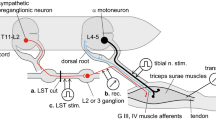Summary
The effect of diazepam (Valium “Roche”) on the amplitude of mono-and polysynaptic reflex potentials, on post- and presynaptic inhibition and on dorsal root potentials has been investigated using spinalized cats anaesthetized with pentobarbital sodium.
Mono- and polysynaptic reflex potentials evoked by electrical stimulation of muscle and cutaneous nerves of the hind limb and recorded from ventral roots or peripheral nerves were reduced but never abolished by intravenous injection of diazepam. As for all other effects described in this paper the minimal effective dose was around 0.05 mg/kg. Maximal effects were obtained with doses of 0.5–1.0 mg/kg.
Diazepam did not influence the amount and time course of postsynaptic inhibition of motoneurons. It did, however, increase and prolong the presynaptic inhibition of monosynaptic reflexes.
These changes of presynaptic inhibition were also reflected in an increase and prolongation of the dorsal root potentials evoked either by electrical stimulation of muscle and cutaneous nerves or by natural stimulation of skin receptors. An experimental comparison was made between these effects and those produced by barbiturates.
Glycofurol, one of the organic solvents of diazepam, mimics in some respects the effects of diazepam itself.
The importance of these findings in regard to the mode of action of diazepam as a muscle relaxant is discussed.
Zusammenfassung
An spinalisierten und mit Nembutal narkotisierten Katzen wurde die Wirkung von Diazepam (Valium „Roche“) auf die Amplitude monound polysynaptischer Reflexpotentiale, auf prä- und postsynaptische Hemmung und auf das „dorsal root potential“ (DRP) untersucht.
Mono- bzw. polysynaptische Reflexe, die nach Reizung von Muskel- bzw. Hautnerven der Hinterextremität von Vorderwurzeln abgeleitet wurden, konnten durch i. v. Injektion von Diazepam verkleinert, aber nicht zum Verschwinden gebracht werden. Wie für alle anderen Meßgrößen dieser Untersuchung lag die Schwellendosis bei 0,05 mg/kg. Maximale Effekte wurden mit Dosen von 0,5–1,0 mg/kg erzielt.
Die postsynaptische Hemmung von Motoneuronen wurde durch Diazepam nicht beeinflußt. Die präsynaptische Hemmung monosynaptischer Reflexe wurde dagegen vergrößert und verlängert.
Diese Veränderungen der präsynaptischen Hemmung zeigten sich auch in einer Vergrößerung und Verlängerung des DRP. Das DRP wurde entweder durch elektrische Reizung von Haut- und Muskelnerven oder durch mechanische Hautreizung erzeugt. Ein experimenteller Vergleich der Diazepamwirkung und der Barbituratwirkung auf das DRP wurde durchgeführt.
Glykofurol, ein Bestandteil des organischen Lösungsvermittlers von Diazepam, hat teilweise ähnliche Wirkungen wie Diazepam selbst.
Die Bedeutung dieser Befunde im Hinblick auf die muskelrelaxierende Wirkung von Diazepam wird besprochen.
Similar content being viewed by others
Literatur
Eccles, J. C.: The physiology of synapses, pp. 1–316. Berlin, Göttingen, Heidelberg: Springer 1964.
——, and R. F. Schmidt: Central pathways responsible for depolarization of primary afferent fibres. J. Physiol. (Lond.) 161, 237–257 (1962a).
—— —— —— Presynaptic inhibition of the central actions of flexor reflex afferents. J. Physiol. (Lond.) 161, 258–281 (1962b).
——, and W. D. Willis: Presynaptic inhibition of the spinal monosynaptic reflex pathway. J. Physiol. (Lond.) 161, 282–297 (1962).
—— —— —— The location and the mode of action of the presynaptic inhibitory pathways on the Group I afferent fibers from muscle. J. Neurophysiol. 26, 506–522 (1963a).
—— —— —— Depolarization of the central terminals of cutaneous afferent fibers. J. Neurophysiol. 26, 646–661 (1963b).
—— —— —— Pharmacological studies on presynaptic inhibition. J. Physiol. (Lond.) 168, 500–530 (1963c).
——, and A. Lundberg: Supraspinal control of interneurones mediating spinal reflexes. J. Physiol. (Lond) 147, 565–584 (1959).
Lloyd, D. P. C.: A direct central inhibitory action of dromically conducted impulses J. Neurophysiol. 4, 184–190 (1941).
Pletscher, A.: Zentrale Wirkungsmechanismen von Psychopharmaka. In: Funktionsabläufe unter emotionellen Belastungen, S. 25–42. Herausg.: K. Fellinger. Basel: S. Karger 1964.
Randall, L. O., G. A. Heise, W. Schallek, R. E. Bagdon, R. Banzinger, A. Boris, R. A. Moe, and W. B. Abrams: Pharmacological and clinical studies on Valium a new psychotherapeutic agent of the benzodiazepine class. Curr. ther. Res. 3, 405–425 (1961).
—— u. G. Zbinden: Zur Pharmakologie von Valium, einem neuen Psychopharmakon der Benzodiazepinreihe. Schweiz. med. Wschr. 93, 794–797 (1963).
Schmidt, R. F.: Pharmacology studies on the primary afferent depolarization of the toad spinal cord. Pflügers Arch. ges. Physiol. 277, 325–346 (1963).
Schmidt, R. F.: The pharmacology of presynaptic inhibition. In: Progress in Brain Research, Vol. 12, Physiology of Spinal Neurons, pp. 119–134. Ed. by Eccles, J. C., and J. P. Schadé, Amsterdam: Elsevier Publ. Comp. 1964.
—— The effect of drugs on the reflex paths to primary afferent fibres. In: Studies in Physiology, pp. 243–249. Ed. by Curtis, D. R., and A. McIntyre. Berlin, Heidelberg, New York: Springer 1965a.
-- Die Wirkung von Diazepam (Valium „Roche“) auf synaptische Funktionen des Rückenmarks. Communicationes, VI. Internat. Congr. Electroenceph. clin. Neurophysiol., Wien, pp. 627–630 (1965b).
——, and M. Zimmermann: Excitability measurements at the central terminals of single mechano-receptor afferents during slow potential changes. Exp. Brain Res. 3, 220–233 (1967a).
—— —— —— Presynaptic depolarization of cutaneous mechanoreceptor afferents after mechanical skin stimulation. Exp. Brain Res. 3, 234–247 (1967b).
——, and M. Zimmermann: Dorsal root potentials evoked by natural stimulation of cutaneous afferents. Nature (Lond.) 212, 522–523 (1966).
Spiegelberg, H., R. Schläpfer, G. Zbinden u. A. Studer: Ein neues injizierbares Lösungsmittel (Glycofurol). Arzneimittel-Forsch. (Drug Res.) 6, 75–77 (1956).
Author information
Authors and Affiliations
Additional information
Mit Unterstützung der Deutschen Forschungsgemeinschaft und der Fa. Deutsche Hoffmann La-Roche AG.
Rights and permissions
About this article
Cite this article
Schmidt, R.F., Vogel, M.E. & Zimmermann, M. Die Wirkung von Diazepam auf die präsynaptische Hemmung und andere Rückenmarksreflexe. Naunyn-Schmiedebergs Arch. Pharmak. u. Exp. Path. 258, 69–82 (1967). https://doi.org/10.1007/BF00535931
Received:
Issue Date:
DOI: https://doi.org/10.1007/BF00535931




